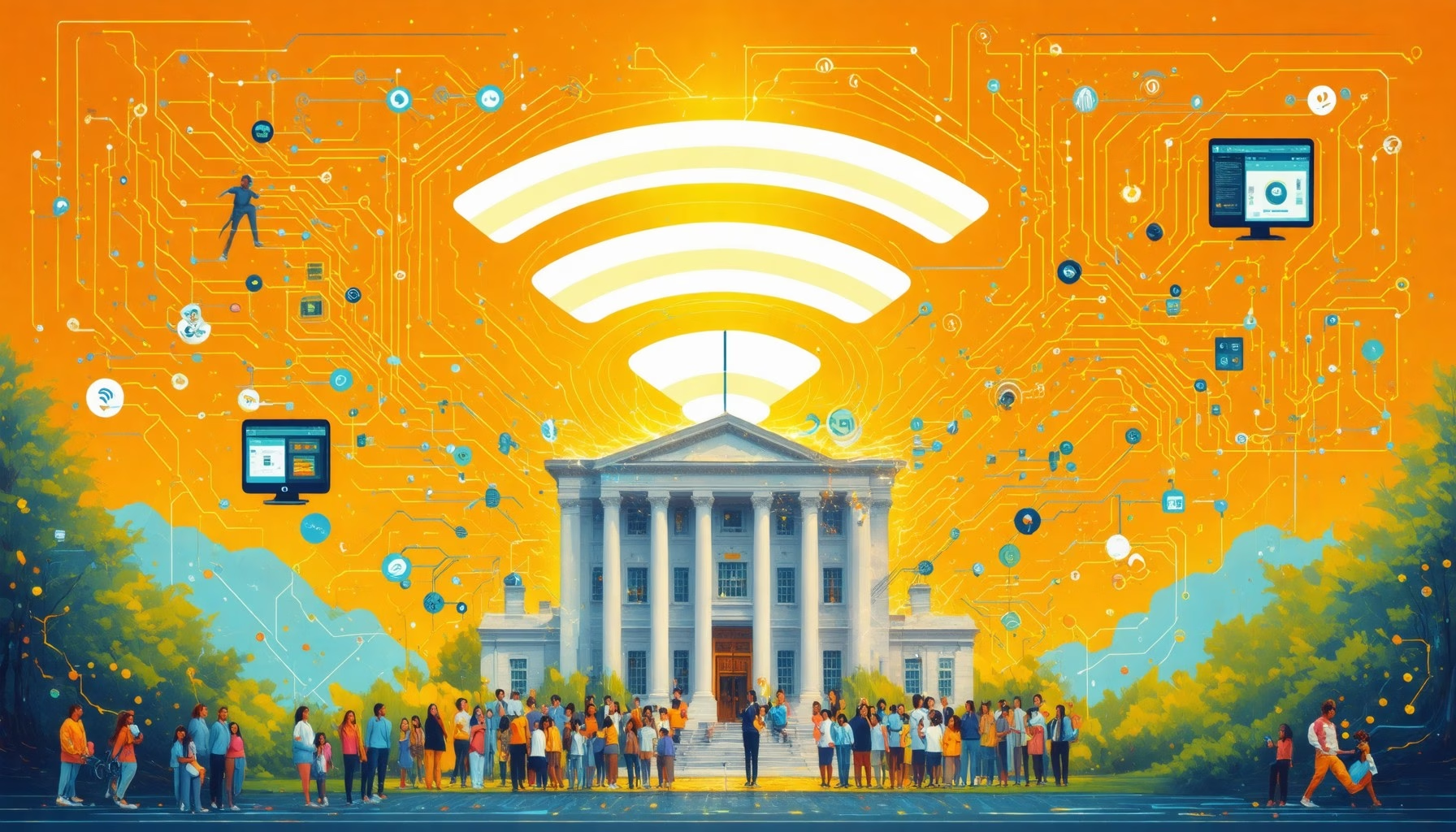Key Takeaways
- Discover how to access free internet with government assistance through programs like the Affordable Connectivity Program (ACP).
- Eligibility for free internet typically includes low-income households, those receiving SNAP, Medicaid, or similar assistance.
- Research local community initiatives and ISPs that offer affordable internet solutions tailored for low-income families.
- Learn the application process for government programs to ensure you maximize your benefits effectively.
- Stay updated on new opportunities and resources to maintain affordable connectivity for your household.
In today’s digital age, access to the internet is not just a luxury; it’s a necessity. For many low-income households, the cost of internet services can be a significant barrier to connectivity. Fortunately, there are various programs designed to provide free internet with government assistance, ensuring that everyone has the opportunity to stay connected. This comprehensive guide will navigate you through the essential aspects of obtaining free home internet from government initiatives, including an overview of available programs, eligibility criteria, and the application process. We will explore financial support options, such as how to apply for free internet service with food stamps, and highlight state-specific programs like the Affordable Connectivity Program in Wisconsin. Additionally, we will discuss how to access low-cost internet solutions and maximize opportunities for absolutely free internet. By the end of this article, you will be equipped with the knowledge and resources needed to empower your household with affordable connectivity, ensuring that you can take full advantage of the digital world.
Understanding Government Assistance for Free Internet
Access to the internet has become essential for education, employment, and communication. Fortunately, various government programs are designed to help low-income households secure free or affordable internet services. Understanding these programs can empower you to take advantage of the resources available to you.
Overview of Government Programs for Free Internet
To get free home internet from the government, follow these steps:
- Eligibility Check: Determine if you qualify for government assistance programs. The Federal Communications Commission (FCC) offers the Affordable Connectivity Program (ACP), which provides discounts on internet services for eligible low-income households.
- Application Process:
- Visit the FCC’s official website (fcc.gov) to apply for the ACP. You will need to provide documentation proving your eligibility, such as income statements or participation in government assistance programs like SNAP or Medicaid.
- Alternatively, you can apply directly through participating internet service providers (ISPs) that offer ACP discounts. Major ISPs like Comcast, AT&T, and Verizon have specific programs to assist low-income families.
- Local Community Programs: Research local community initiatives that may offer free or low-cost internet access. Many local governments and nonprofit organizations provide resources for families in need. Websites like EveryoneOn.org can help you find local programs tailored to your area.
- School and Library Programs: Check with your child’s school or local library, as many educational institutions have partnerships with ISPs to provide free internet access to students and families.
- Stay Informed: Keep an eye on updates from the FCC and local government websites for new programs or changes to existing ones. The landscape of internet assistance is evolving, and new opportunities may arise.
For more detailed information on the Affordable Connectivity Program and to apply, visit the FCC’s website at fcc.gov/affordable-connectivity-program.
Eligibility Criteria for Free Internet with Government Assistance
Eligibility for free internet services through government assistance programs typically depends on income level and participation in other federal assistance programs. Here are the key criteria:
- Households with an income at or below 200% of the Federal Poverty Guidelines are generally eligible.
- Participation in programs such as SNAP, Medicaid, or Federal Public Housing Assistance can qualify you for discounts.
- Eligibility may also extend to households with children receiving free or reduced-price school lunches.
- Some states have additional criteria or programs that may provide further assistance; check local resources for specifics.
Understanding these eligibility criteria can help you navigate the application process more effectively and ensure you receive the support you need.

Understanding Government Assistance for Free Internet
Access to free internet with government assistance is a vital resource for low-income families, enabling them to connect with essential services, education, and employment opportunities. Various government programs are designed to help individuals secure affordable internet access, ensuring that no one is left behind in the digital age.
Overview of Government Programs for Free Internet
Several government initiatives exist to provide free internet with government assistance for low-income households. One of the most notable programs is the Lifeline program, which offers monthly discounts on phone and internet services. This program is specifically aimed at making communication services more affordable for those who qualify based on income or participation in federal assistance programs.
In addition to Lifeline, the Affordable Connectivity Program (ACP) is another significant initiative that provides eligible households with discounts on internet service. The ACP aims to bridge the digital divide by ensuring that low-income families can access high-speed internet, which is increasingly essential for education and employment.
Eligibility Criteria for Free Internet with Government Assistance
To qualify for free internet with government assistance, applicants must meet specific eligibility criteria. For the Lifeline program, individuals must either have a household income that falls below a certain threshold or participate in qualifying federal assistance programs such as Medicaid, SNAP, or Federal Public Housing Assistance. Eligibility is determined based on household size and income levels.
For the Affordable Connectivity Program, the criteria are similar, focusing on low-income households. Applicants may also qualify if they receive benefits from programs like the National School Lunch Program or the Supplemental Security Income (SSI). Understanding these eligibility requirements is crucial for families seeking to access free internet services.
Exploring Financial Support for Internet Services
Access to the internet is essential for modern living, and fortunately, there are various government programs designed to help low-income households secure free internet with government assistance. Understanding these financial support options can empower you to take advantage of the resources available to you.
Types of Government Assistance Available
Several programs provide financial support for internet services, particularly for low-income families. Here are some key options:
- Affordable Connectivity Program (ACP): This initiative helps eligible households afford internet service by providing discounts on monthly bills. You can learn more about the ACP here.
- Lifeline Program: This federal program offers discounts on phone and internet services for low-income individuals. It’s designed to ensure that everyone has access to essential communication services. More details can be found in our Lifeline WiFi program guide.
- Local ISP Programs: Many internet service providers (ISPs) offer their own low-cost plans for eligible customers. For instance, programs like Cox Connect2Compete and Xfinity Internet Essentials provide affordable internet options for families participating in government assistance programs.
How to Apply for Free Internet Service with Food Stamps
If you are receiving food stamps (SNAP), you may qualify for low-cost internet services. Here’s how to navigate the application process:
- Check Eligibility: To qualify for low-cost internet programs, you typically need to participate in government assistance programs such as SNAP, Medicaid, or the National School Lunch Program. These programs are designed to help low-income families access essential services.
- Research Local Providers: Investigate internet service providers (ISPs) in your area. Many ISPs offer specific low-income plans that can provide internet access for around $10 a month. Contact these providers directly to inquire about their low-income programs and the eligibility criteria.
- Application Process: Once you confirm your eligibility, apply for the low-cost internet service. This can usually be done through the provider’s website or by calling their customer service. Be prepared to provide documentation that verifies your participation in a qualifying assistance program.
For more information on low-cost internet options, you can visit the Federal Communications Commission (FCC) website, which provides resources and guidance on affordable internet access for low-income families.
Maximizing Free Internet Opportunities
Accessing free internet with government assistance can significantly enhance the quality of life for low-income families. Understanding the available resources is essential for those seeking to bridge the digital divide. Here, we explore various programs and local providers that offer free internet services to eligible households.
Resources for Free Government Internet for Low-Income Families
Several government initiatives are designed to provide free internet access to low-income families. One of the most notable is the Affordable Connectivity Program (ACP), which offers financial assistance to eligible households. This program allows families to receive a discount on their internet service, making it more affordable and accessible.
In addition to the ACP, local internet service providers often collaborate with government programs to offer free or low-cost internet solutions. For example, many providers participate in the Lifeline WiFi program, which helps low-income households access essential internet services at reduced rates. To find out more about these options, you can visit the Lifeline WiFi program page.
Local Providers Offering Free Internet with Government Assistance Near Me
Finding local providers that offer free internet services can be a game-changer for families in need. Many internet service providers partner with government assistance programs to ensure that low-income households can access the internet without financial strain. To locate these providers, you can check with your local government or community organizations that focus on digital equity.
Additionally, websites like FCC provide resources and tools to help you identify available internet service options in your area. By leveraging these resources, families can secure free internet with government assistance, ensuring they stay connected to vital services and opportunities.

Maximizing Free Internet Opportunities
Accessing free internet with government assistance can significantly enhance connectivity for low-income families. Understanding the available resources is crucial for maximizing these opportunities. Here are some key resources that can help you secure free internet services:
Resources for Free Government Internet for Low-Income Families
To get absolutely free internet, consider the following options:
- FCC Lifeline Program: This federal initiative provides eligible low-income households with discounts on internet services, potentially offering free access. To apply, visit the Lifeline Support website and check your eligibility.
- Community Programs: Many local governments and non-profit organizations offer free or low-cost internet services. Research community resources in your area, as they may have partnerships with internet service providers to deliver affordable options.
- Internet Service Provider Promotions: Some ISPs offer promotional deals that include free internet for a limited time. Companies like Comcast and AT&T have programs aimed at low-income families, such as Internet Essentials and Access from AT&T. Check their websites for eligibility and application details.
- Public Wi-Fi Access: Libraries, cafes, and community centers often provide free Wi-Fi. While this is not a permanent solution, it can be a way to access the internet without cost.
- Government Assistance Programs: In addition to Lifeline, programs like the Emergency Broadband Benefit (EBB) provide temporary financial assistance for internet services during emergencies. Visit the FCC’s website for more details on how to apply.
- Mobile Hotspot Options: Some mobile carriers offer free or low-cost mobile hotspot services. Check with providers like T-Mobile or Verizon for any available plans that may suit your needs.
Local Providers Offering Free Internet with Government Assistance Near Me
Finding local providers that offer free internet with government assistance is essential for low-income families. Here are steps to identify these providers:
- Research Local ISPs: Start by searching for internet service providers in your area. Many local ISPs participate in government programs to provide discounted or free internet services.
- Check Community Resources: Local libraries and community centers often have information on available programs. They may also host events or workshops to help families apply for assistance.
- Utilize Online Tools: Websites like HighSpeedInternet.com can help you compare internet options and find providers that offer government-assisted plans.
- Contact Local Government Offices: Reach out to your local government offices or social services to inquire about programs available in your area that provide free internet access.
How long does ACP take to get approved?
The approval process for the Affordable Connectivity Program (ACP) involves several key steps, each with its own timeframe:
- Account Creation: Setting up an account on the National Verifier typically takes about 5-10 minutes. This step is crucial as it allows applicants to provide necessary personal information and documentation.
- Application Review: Once the application is submitted, it is generally reviewed and either approved or rejected within 10-15 minutes. This rapid processing time is designed to streamline access to the program.
- Confirmation: After receiving approval, applicants may need to wait an additional 1-2 days to receive confirmation from their internet service provider regarding the status of the ACP subsidy.
- Subsidy Activation: Following approval and confirmation, the ACP subsidy is expected to take effect during the next billing cycle. This means that eligible participants can start benefiting from reduced internet costs shortly after their application is processed.
For more detailed information, you can refer to the official ACP resources available on the Federal Communications Commission website, which outlines the program’s eligibility criteria and application process. Additionally, the National Verifier’s guidelines provide comprehensive support for applicants navigating this process.
What to Expect After Applying for Free Internet Assistance
After submitting your application for free internet assistance through the ACP, you can expect the following:
- Notification of Status: You will receive a notification regarding your application status, typically within a few minutes to a couple of days, depending on the processing time.
- Documentation Requirements: Be prepared to provide additional documentation if requested by your internet service provider or the National Verifier to verify your eligibility.
- Service Provider Contact: Once approved, your internet service provider will reach out to confirm your enrollment in the program and discuss the next steps for activating your service.
- Ongoing Eligibility Checks: Keep in mind that your eligibility for the ACP may be reviewed periodically, so ensure you maintain the necessary qualifications to continue receiving benefits.
For further assistance, you can explore resources on Affordable Connectivity Program and related government assistance programs.
How to get free home internet from government?
Accessing free home internet through government assistance programs is a vital resource for many low-income families. These programs aim to bridge the digital divide, ensuring that everyone has the opportunity to connect to the internet for education, work, and communication. Understanding the various government initiatives available can help you secure free internet services effectively.
Understanding Government Assistance for Free Internet
Government assistance for free internet primarily revolves around programs designed to support low-income households. The most notable initiative is the Affordable Connectivity Program (ACP), which provides eligible households with discounts on internet services. This program is crucial for ensuring that families can afford reliable internet access, which has become essential in today’s digital age.
Overview of Government Programs for Free Internet
Several government programs offer free or discounted internet services. The Affordable Connectivity Program is one of the most significant, providing eligible households with a monthly discount of up to $30 on internet services. Additionally, the Lifeline program offers a similar discount for low-income individuals, ensuring that they can maintain connectivity. These programs are designed to assist those who may struggle to afford internet services due to financial constraints.
Eligibility Criteria for Free Internet with Government Assistance
To qualify for government assistance programs for free internet, applicants typically need to meet specific income requirements. For instance, the ACP is available to households with incomes at or below 200% of the federal poverty guidelines or those who participate in certain federal assistance programs, such as SNAP or Medicaid. It’s essential to check the eligibility criteria for each program, as they may vary slightly. You can find more detailed information about eligibility on the Benefits.gov website.
Can the government pay for my internet?
Yes, the government can provide financial support for internet services through various assistance programs aimed at low-income households. These programs are designed to help individuals and families who may not be able to afford internet access on their own.
Exploring Financial Support for Internet Services
Financial support for internet services comes in several forms, primarily through government-funded programs that offer discounts or subsidies. The Affordable Connectivity Program and Lifeline are two key initiatives that provide financial assistance to eligible households, ensuring that they can access essential internet services without incurring significant costs.
Types of Government Assistance Available
The main types of government assistance available for internet services include:
- Affordable Connectivity Program (ACP): Offers a monthly discount on internet services for eligible households.
- Lifeline Program: Provides a discount on monthly internet bills for low-income individuals.
- State-Specific Programs: Some states have additional programs that offer free or discounted internet services to residents.
How to Apply for Free Internet Service with Food Stamps
If you are a recipient of food stamps (SNAP), you may qualify for free or discounted internet services. To apply, you typically need to provide proof of your participation in the SNAP program when applying for the ACP or Lifeline. The application process usually involves filling out a form online or through your internet service provider. For more detailed guidance on the application process, visit the Affordable Connectivity Program page.




